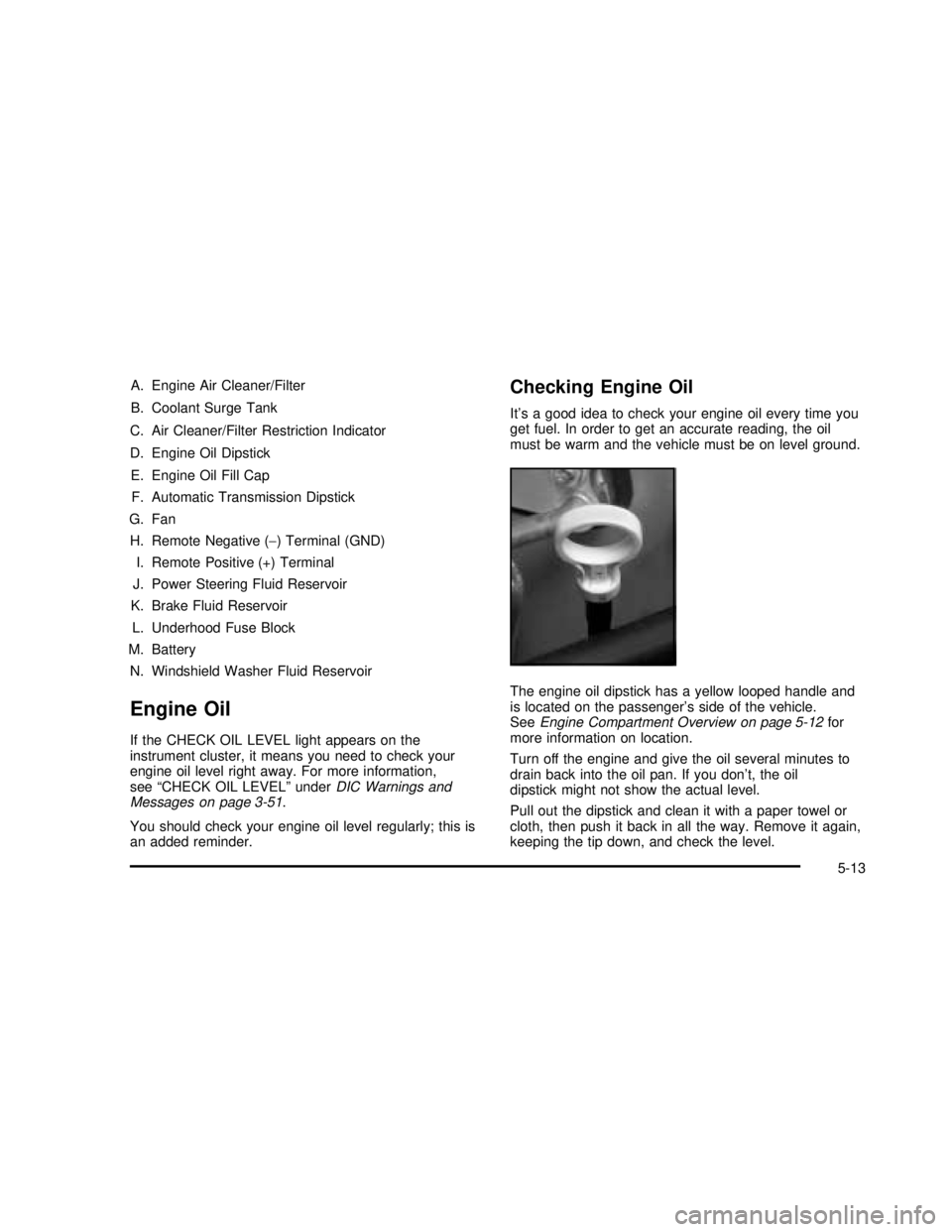washer fluid GMC SIERRA 2003 Owner's Manual
[x] Cancel search | Manufacturer: GMC, Model Year: 2003, Model line: SIERRA, Model: GMC SIERRA 2003Pages: 408, PDF Size: 2.58 MB
Page 174 of 408

SERVICE 4WD
If a problem occurs with the four wheel drive system,
this message will appear on the DIC. If this message
appears, stop as soon as possible and turn off the
vehicle. Restart the vehicle and check for the message
on the DIC display. If the message is still displayed,
or appears again when you begin driving, the four wheel
drive system needs service.
SERVICE AIR SUSPENSION
If a problem occurs with the suspension system, this
message will appear on the DIC. If this message
appears, stop as soon as possible and turn off the
vehicle. Restart the vehicle and check for the message
on the DIC display. If the message is still displayed,
or appears again when you begin driving, the air
suspension system needs service.
TURN SIGNAL ON
If a turn signal is left on for 3/4 of a mile (1.2 km), this
message will appear on the display and you will
hear a chime. Move the turn signal/multifunction lever to
the off position. Pressing the select button will
acknowledge this message and clear it from the DIC
display.
CARGO LAMP ON
If the cargo lamp is on, this message will appear on the
DIC and you will hear a chime. Turn off the vehicle
and check the liftgate. Restart the vehicle and check for
the message on the DIC display. Pressing the select
button will acknowledge this message and clear it from
the DIC display.
FUEL LEVEL LOW
If the fuel level is low, this message will appear on the
DIC and you will hear a chime. Refuel as soon as
possible. Pressing the select button will acknowledge
this message and clear it from the DIC display.
CHECK OIL LEVEL
If the oil level in the vehicle is low, this message will
appear on the DIC. Check and oil level and correct it as
necessary. You may need to let the vehicle cool or
warm up and cycle the ignition to be sure this message
will clear. Once the problem is corrected, pressing
the select button will clear this message from the DIC
display.
CHECK WASHER FLUID
If the washerfluid level is low, this message will appear
on the DIC. Adding washerfluid will clear the message.
Pressing the select button will acknowledge this
message and clear it from the DIC display.
3-54
2003 - Sierra Denali
Page 235 of 408

Once you are moving on the freeway, make certain you
allow a reasonable following distance. Expect to
move slightly slower at night.
When you want to leave the freeway, move to the
proper lane well in advance. If you miss your exit, do
not, under any circumstances, stop and back up. Drive
on to the next exit.
The exit ramp can be curved, sometimes quite sharply.
The exit speed is usually posted.
Reduce your speed according to your speedometer, not
to your sense of motion. After driving for any distance
at higher speeds, you may tend to think you are
going slower than you actually are.
Before Leaving on a Long Trip
Make sure you’re ready. Try to be well rested. If you
must start when you’re not fresh—such as after a day’s
work—don’t plan to make too many miles that�rst
part of the journey. Wear comfortable clothing and shoes
you can easily drive in.
Is your vehicle ready for a long trip? If you keep it
serviced and maintained, it’s ready to go. If it needs
service, have it done before starting out. Of course,you’ll�nd experienced and able service experts in GM
dealerships all across North America. They’ll be
ready and willing to help if you need it.
Here are some things you can check before a trip:
Windshield Washer Fluid:Is the reservoir full? Are
all windows clean inside and outside?
Wiper Blades:Are they in good shape?
Fuel, Engine Oil, Other Fluids:Have you checked
all levels?
Lamps:Are they all working? Are the lenses clean?
Tires:They are vitally important to a safe,
trouble-free trip. Is the tread good enough for
long-distance driving? Are the tires all in�ated to the
recommended pressure?
Weather Forecasts:What’s the weather outlook
along your route? Should you delay your trip a
short time to avoid a major storm system?
Maps:Do you have up-to-date maps?
4-37
2003 - Sierra Denali
Page 261 of 408

Service............................................................5-3
Doing Your Own Service Work.........................5-3
Adding Equipment to the Outside of
Your Vehicle..............................................5-4
Fuel................................................................5-4
Gasoline Octane............................................5-4
Gasoline Specifications....................................5-5
California Fuel...............................................5-5
Additives.......................................................5-6
Fuels in Foreign Countries...............................5-6
Filling Your Tank............................................5-7
Filling a Portable Fuel Container.......................5-9
Checking Things Under
the Hood....................................................5-10
Hood Release..............................................5-10
Engine Compartment Overview.......................5-12
Engine Oil...................................................5-13
Engine Air Cleaner/Filter................................5-18
Automatic Transmission Fluid.........................5-20
Engine Coolant.............................................5-23
Coolant Surge Tank Pressure Cap..................5-26
Engine Overheating.......................................5-26
Cooling System............................................5-29Engine Fan Noise.........................................5-34
Power Steering Fluid.....................................5-34
Windshield Washer Fluid................................5-35
Brakes........................................................5-36
Battery........................................................5-39
Jump Starting...............................................5-40
All-Wheel Drive..............................................5-45
Rear Axle.......................................................5-46
Front Axle......................................................5-47
Bulb Replacement..........................................5-48
Halogen Bulbs..............................................5-48
Headlamps..................................................5-48
Front Turn Signal, Sidemarker and
Daytime Running Lamps.............................5-49
Roof Marker Lamps......................................5-51
Center High-Mounted Stoplamp (CHMSL)
and Cargo Lamp.......................................5-52
Pickup Box Identification and Fender
Marker Lamps...........................................5-54
Taillamps.....................................................5-54
Replacement Bulbs.......................................5-55
Windshield Wiper Blade Replacement
..............5-56
Section 5 Service and Appearance Care
5-1
2003 - Sierra Denali
Page 273 of 408

A. Engine Air Cleaner/Filter
B. Coolant Surge Tank
C. Air Cleaner/Filter Restriction Indicator
D. Engine Oil Dipstick
E. Engine Oil Fill Cap
F. Automatic Transmission Dipstick
G. Fan
H. Remote Negative (−) Terminal (GND)
I. Remote Positive (+) Terminal
J. Power Steering Fluid Reservoir
K. Brake Fluid Reservoir
L. Underhood Fuse Block
M. Battery
N. Windshield Washer Fluid Reservoir
Engine Oil
If the CHECK OIL LEVEL light appears on the
instrument cluster, it means you need to check your
engine oil level right away. For more information,
see“CHECK OIL LEVEL”underDIC Warnings and
Messages on page 3-51.
You should check your engine oil level regularly; this is
an added reminder.
Checking Engine Oil
It’s a good idea to check your engine oil every time you
get fuel. In order to get an accurate reading, the oil
must be warm and the vehicle must be on level ground.
The engine oil dipstick has a yellow looped handle and
is located on the passenger’s side of the vehicle.
SeeEngine Compartment Overview on page 5-12for
more information on location.
Turn off the engine and give the oil several minutes to
drain back into the oil pan. If you don’t, the oil
dipstick might not show the actual level.
Pull out the dipstick and clean it with a paper towel or
cloth, then push it back in all the way. Remove it again,
keeping the tip down, and check the level.
5-13
2003 - Sierra Denali
Page 295 of 408

How to Check Power Steering Fluid
Turn the key off, let the engine compartment cool down,
wipe the cap and the top of the reservoir clean, then
unscrew the cap and wipe the dipstick with a clean rag.
Replace the cap and completely tighten it. Then remove
the cap again and look at thefluid level on the dipstick.
The level should be at the FULL COLD mark. If
necessary, add only enoughfluid to bring the level up to
the mark.
What to Use
To determine what kind offluid to use, seePart D:
Recommended Fluids and Lubricants on page 6-15.
Always use the properfluid. Failure to use the proper
fluid can cause leaks and damage hoses and seals.
Windshield Washer Fluid
What to Use
When you need windshield washerfluid, be sure to read
the manufacturer’s instructions before use. If you will
be operating your vehicle in an area where the
temperature may fall below freezing, use afluid that has
sufficient protection against freezing. SeeEngine
Compartment Overview on page 5-12for reservoir
location.
Adding Washer Fluid
Open the cap with the
washer symbol on it. Add
washerfluid until the
tank is full.
Notice:
•When using concentrated washerfluid, follow the
manufacturer’s instructions for adding water.
•Don’t mix water with ready-to-use washerfluid.
Water can cause the solution to freeze and
damage your washerfluid tank and other parts of
the washer system. Also, water doesn’t clean as
well as washerfluid.
•Fill your washerfluid tank only three-quarters full
when it’s very cold. This allows for expansion if
freezing occurs, which could damage the tank if
it is completely full.
•Don’t use engine coolant (antifreeze) in your
windshield washer. It can damage your washer
system and paint.
5-35
2003 - Sierra Denali
Page 359 of 408

Fuses Usage
FOG LP Fog Lamp Relay
FOG LP Fog Lamps
HORN Horn Relay
W/S WASHWindshield Washer Pump
Relay
W/S WASH Windshield Washer Pump
INFOOnStar/Rear Seat
EntertainmentFuses Usage
RADIO AMP Radio Amplifier
RH HID Not Used
HORN Horn
EAP Not Used
TREC All-Wheel Drive Module
SBA Supplemental Brake Assist
Capacities and Specifications
Capacities and Specifications
ApplicationCapacities
English Metric
Cooling System 14.8 quarts 14.0 L
Engine Oil with Filter 6.0 quarts 5.7 L
Fuel Tank 26.0 gallons 98.4 L
Air Conditioning Refrigerant R134a 1.6 lbs. 0.7 kg
Use Refrigerant Oil, R134a Systems
All capacities are approximate. When adding, be sure tofill to the approximate level, as recommended in this
manual. SeePart D: Recommended Fluids and Lubricants on page 6-15.
5-99
2003 - Sierra Denali
Page 370 of 408

Part B: Owner Checks and Services
Listed in this part are owner checks and services
which should be performed at the intervals speci�ed to
help ensure the safety, dependability and emission
control performance of your vehicle.
Be sure any necessary repairs are completed at once.
Whenever any�uids or lubricants are added to your
vehicle, make sure they are the proper ones, as shown
in Part D.
At Each Fuel Fill
It is important for you or a service station attendant to
perform these underhood checks at each fuelfill.
Engine Oil Level Check
Check the engine oil level and add the proper oil if
necessary. SeeEngine Oil on page 5-13for further
details.
Engine Coolant Level Check
Check the engine coolant level and add DEX-COOL®
coolant mixture if necessary. SeeEngine Coolant
on page 5-23for further details.
Windshield Washer Fluid Level Check
Check the windshield washer�uid level in the windshield
washer tank and add the proper�uid if necessary.
SeeWindshield Washer Fluid on page 5-35for further
details.
At Least Once a Month
Tire Inflation Check
Make sure tires are in�ated to the correct pressures.
Don’t forget to check your spare tire. SeeTires on
page 5-56for further details.
Cassette Tape Player Service
Clean cassette tape player. Cleaning should be done
every 50 hours of tape play. SeeAudio System(s)
on page 3-56for further details.
At Least Twice a Year
Restraint System Check
Make sure the safety belt reminder light and all your
belts, buckles, latch plates, retractors and anchorages
are working properly. Look for any other loose or
damaged safety belt system parts. If you see anything
that might keep a safety belt system from doing its
job, have it repaired. Have any torn or frayed safety belts
replaced.
6-10
2003 - Sierra Denali
Page 375 of 408

Transfer Case and Front Axle
(All-Wheel Drive) Inspection
Every 12 months, or at engine oil change intervals,
check front axle and transfer case and add lubricant
when necessary. A�uid loss could indicate a problem.
Check and have it repaired, if needed. Check vent
hose at transfer case for kinks and proper installation.
Brake System Inspection
Inspect the complete system. Inspect brake lines and
hoses for proper hook-up, binding, leaks, cracks,
cha�ng, etc. Inspect disc brake pads for wear and rotors
for surface condition. Inspect other brake parts,
including calipers, parking brake, etc. You may need to
have your brakes inspected more often if your driving
habits or conditions result in frequent braking.
Part D: Recommended Fluids and
Lubricants
Fluids and lubricants identi�ed below by name, part
number or speci�cation may be obtained from your
dealer.
Usage Fluid/Lubricant
Engine OilEngine oil with the American
Petroleum Institute Certi�ed for
Gasoline Engines starburst symbol
of the proper viscosity. To determine
the preferred viscosity for your
vehicle’s engine, seeEngine Oil on
page 5-13.
Engine Coolant50/50 mixture of clean, drinkable
water and use only
DEX-COOL
®Coolant. SeeEngine
Coolant on page 5-23.
Hydraulic Brake
SystemDelco Supreme 11 Brake Fluid or
equivalent DOT-3 brake�uid.
Windshield
Washer SolventGM Optikleen
®Washer Solvent or
equivalent.
Power Steering
SystemGM Power Steering Fluid (GM Part
No. U.S. 1052884, in Canada
993294, or equivalent).
Automatic
TransmissionDEXRON
®-III Automatic
Transmission Fluid.
6-15
2003 - Sierra Denali
Page 391 of 408

A
Accessory Power Outlets.................................3-16
Adding Washer Fluid.......................................5-35
Additional Program Information........................... 7-8
Additives, Fuel................................................. 5-6
Add-On Electrical Equipment............................5-91
Add-On Equipment..........................................4-50
Adjusting the Speakers (Balance/Fade)..............3-60
After Off-Road Driving.....................................4-30
Air Bag
Off Light.....................................................3-28
Passenger Status Indicator...........................3-31
Readiness Light..........................................3-27
Air Bag Systems.............................................1-55
Adding Equipment to Your Air Bag-Equipped
Vehicle...................................................1-71
Air Bag Off Switch.......................................1-61
How Does an Air Bag Restrain?....................1-59
Passenger Sensing System...........................1-66
Servicing Your Air Bag-Equipped Vehicle.........1-70
What Makes an Air Bag Inflate?....................1-59
What Will You See After an Air Bag Inflates?......1-59
When Should an Air Bag Inflate?...................1-58
Where Are the Air Bags?
..............................1-57
Air Cleaner/Filter, Engine
.................................5-18
Air Conditioning
..............................................3-21
All Overseas Locations
...................................... 7-4
All-Wheel Drive
...............................................5-45
All-Wheel Drive (AWD) System
.........................2-21AM ...............................................................3-76
Antenna, Fixed Mast.......................................3-78
Antenna, XM™ Satellite Radio Antenna System.....3-78
Anti-lock Brake System..................................... 4-6
Anti-Lock Brake, System Warning Light..............3-35
Appearance Care............................................5-82
Care of Safety Belts....................................5-84
Chemical Paint Spotting...............................5-88
Cleaning the Inside of Your Vehicle................5-83
Cleaning the Outside of Your Vehicle..............5-85
Finish Damage............................................5-87
GM Vehicle Care/Appearance Materials..........5-88
Sheet Metal Damage...................................5-87
Underbody Maintenance...............................5-87
Weatherstrips..............................................5-85
Approaching a Hill..........................................4-23
Ashtrays........................................................3-17
Audio System(s).............................................3-56
Audio Steering Wheel Controls......................3-76
Care of Your Cassette Tape Player................3-77
Care of Your CD Player...............................3-78
Care of Your CDs ........................................3-78
CD Changer
...............................................3-73
Fixed Mast Antenna
.....................................3-78
Navigation/Radio System
..............................3-70
Radio with Cassette and CD
.........................3-57
Rear Seat Audio (RSA)
................................3-71
Setting the Time
..........................................3-57
Theft-Deterrent Feature
................................3-75
Understanding Radio Reception
.....................3-76
1
2003 - Sierra Denali
Page 393 of 408

Care of (cont.)
Your CD Player...........................................3-78
Your CDs ...................................................3-78
Cargo Lamp...................................................3-14
CARGO LAMP ON .........................................3-54
Cassette Tape Messages.................................3-67
Cassette Tape Player Service...........................6-10
CD Adapter Kits.............................................3-68
CD Changer...................................................3-73
CD Functions.................................................3-74
Center Console Storage Area...........................2-39
Center High-Mounted Stoplamp (CHMSL)
and Cargo Lamp.........................................5-52
Center Instrument Panel Fuse Block..................5-94
Center Passenger Position, Safety Belts.............1-21
Chains, Tires..................................................5-64
CHANGE ENGINE OIL ....................................3-52
Check
Engine Light...............................................3-37
Check Engine Light.........................................3-37
CHECK OIL LEVEL .........................................3-54
CHECK WASHER FLUID .................................3-54
Checking Brake Fluid......................................5-37
Checking Coolant............................................5-24
Checking Engine Oil........................................5-13
Checking Things Under the Hood
......................5-10
Checking Your Restraint Systems
......................1-71
Chemical Paint Spotting
...................................5-88
Child Restraints
Child Restraint Systems
...............................1-35Child Restraints (cont.)
Infants and Young Children...........................1-31
Lower Anchorages and Top Tethers for
Children (LATCH System)..........................1-42
Older Children.............................................1-29
Securing a Child Restraint Designed for the
LATCH System........................................1-45
Securing a Child Restraint in a Center Rear
Seat Position...........................................1-47
Securing a Child Restraint in a Rear Outside
Seat Position...........................................1-45
Securing a Child Restraint in the Right Front
Seat Position...........................................1-49
Top Strap...................................................1-39
Top Strap Anchor Location............................1-40
Where to Put the Restraint...........................1-38
Cigarette Lighter.............................................3-17
Cleaning
Inside of Your Vehicle..................................5-83
Outside of Your Vehicle................................5-85
Underbody Maintenance...............................5-87
Weatherstrips..............................................5-85
Cleaning Aluminum or Chrome-Plated Wheels.....5-87
Cleaning Exterior Lamps/Lenses.......................5-85
Cleaning Fabric/Carpet....................................5-83
Cleaning Glass Surfaces..................................5-84
Cleaning Interior Plastic Components
.................5-84
Cleaning Leather
............................................5-83
Cleaning the Mirror
.........................................2-30
Cleaning the Top of the Instrument Panel
...........5-84
3
2003 - Sierra Denali